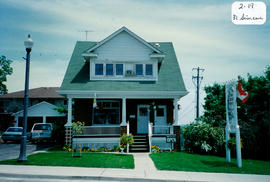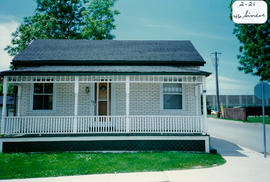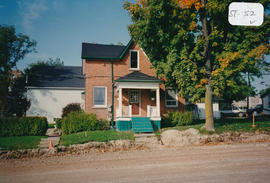31 Simcoe Road - The Wilkinson House
- CA BWGPL GJ-HB-2017-04-21-04
- Item
- 1996
Part of George Jackson fonds
The Wilkinson House is a mid-block building located at 31 Simcoe Road. It was built by Art Saint and/or George Stoddart around 1923 in the Arts and Crafts style. The house was sold to Chris Long, his daughter, and her husband Fred Wilkinson (a printer for the Bradford Witness) and daughter Marjorie. When they moved to Toronto to work at the DeHavill and Aircraft Company during WWII, the house was sold to a market gardener whose family lived here for many years.
The 1½-storey, two-bay ‘bungalow’ has a simple form with an asymmetrical façade and a rectilinear plan. A broad, steeply-pitched, gable roof extends down to reduce the scale of the building from the street. It covers the open front porch and is supported on wood half columns on brick piers. There is an off-centre hall entrance from the porch. The porch (entered from the front) is raised and has a simple, wood handrail and baluster. There are wide window openings with low floor to ceiling heights. A wide band of windows across the front of the dormer emphasizes the horizontal lines and massing of this house. The wide windows are set into rectangular openings. Smaller, second-storey windows in the front dormer are offset from the ground-floor windows and have plain, wood sills and trim. The windows and the second entrance door are not original. A mix of exterior cladding materials is common to this style. The house has returned eaves at the dormer roof. Wood frame construction has brick, masonry cladding and vinyl siding on the dormer. The original cladding would have been wood. There is a painted, concrete foundation. According to the 2000 inventory, the house is in good condition with many original features that have been maintained well. (1, 2, 3)
George Jackson






